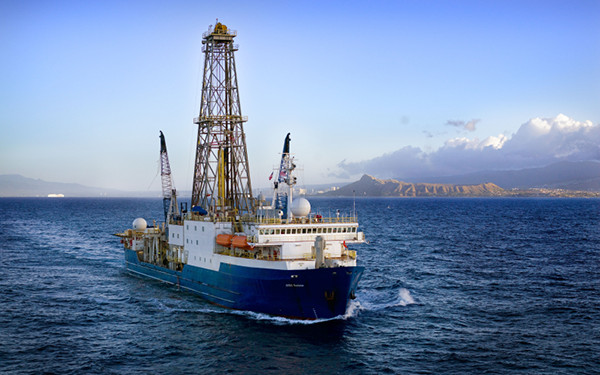
by Robin Wylie Thursday, July 14, 2016

In 2018, researchers aboard International Ocean Discovery Program's JOIDES Resolution ship will drill into an active submarine volcano — Brothers Volcano, part of the Kermadec Arc north of New Zealand — for the first time. Credit: William Crawford, IODP JRSO/TAMU
Earth scientists have been given the green light to drill into an active submarine volcano for the first time, with the hope of discovering substantial new reserves of valuable metals, as well as new forms of extreme life.
In late May, the International Ocean Discovery Program (IODP; formerly the Integrated Ocean Drilling Program) awarded an international team of researchers $15 million to drill directly into Brothers Volcano, which rises from the seafloor to about 1.5 kilometers beneath the surface of the southern Pacific Ocean roughly 450 kilometers off New Zealand’s North Island. The researchers will use the IODP ship JOIDES Resolution to drill a number of boreholes into the volcano, some as deep as 800 meters below its submerged summit.
The two-month expedition to Brothers, slated to begin in May 2018, could return some valuable results. All volcanic magmas contain at least trace amounts of various metals, but the magma and rock within Brothers is unusually rich in metals like gold, silver, copper and molybdenum, and one of the main motivations for drilling into it is to search for massive ore bodies containing these metals, says Cornel de Ronde, a volcanologist at the New Zealand-based research and consulting firm GNS Science.
The researchers do not know the exact quantities of rare metals at Brothers, but de Ronde, who will lead the 2018 expedition, says it could perhaps hold “a few [metric] tons of gold, many more tons of silver, tens of thousands of tons of zinc, and hundreds of thousands of tons of copper.”
Similarly large quantities of precious metals could also be present at other submarine volcanoes. Consequently, de Ronde says, if the 2018 drilling reveals substantial amounts of ore at Brothers, it could suggest that a vast, untapped mineral resource exists beneath the seafloor, spread across the many thousands of submarine volcanoes worldwide.
“Submarine volcanoes might eventually become a strategic resource for rare metals as humans exhaust deposits on land,” de Ronde says. “The biggest barrier to any exploitation will be mining at such depth on the seafloor — it’s not impossible, but it’s a different ball game altogether from mining on land.”
The search for rare metals at Brothers Volcano is more than just a treasure hunt — de Ronde and his colleagues want to answer some big questions about the inner workings of volcanoes as well.
By probing Brothers for metallic ores, they hope to shed light on how volcanoes transport metals from the mantle and deep crust to the oceans. The process by which this happens has been hotly debated for much of the past century. Researchers aren’t sure, for example, if the metals emitted at submarine volcanoes precipitate mostly from volcanic gases, from hydrothermal fluids, or from a combination of both, says Mark Hannington, an economic geologist at the University of Ottawa in Canada and a member of the 2018 expedition team. Discovering the sources of metals at Brothers, and how they’re deposited, should also allow the team to predict where valuable metals are likely to be located, and in what concentrations, Hannington says.
“The vast majority of Earth’s volcanoes occur on the seafloor and are therefore inherently difficult to study,” says Peter Barry, a visiting geochemist at the University of Oxford in England. “As the first expedition of its kind, the IODP project to drill into the Brothers Volcano has the potential to transform our understanding of how submarine volcanoes form and evolve through time.”
In addition to the geologic facets of the mission, the researchers will be on the lookout for biological riches at Brothers. The volcano’s 3-kilometer-wide central crater is surrounded by scores of rocky chimneys, up to 7 meters tall, which emit superheated fluids, the result of chemical reactions between magma and seawater deep within the volcano. Elsewhere, such hydrothermal chimneys are often hot spots of life, and de Ronde says his team expects “to discover [extremophile] microbes that are completely new to science.” Additionally, “the fluids coming out of the [volcanic] cone site are more acidic than battery acid,” he says, so “not only will we be looking for microbes that can survive hot temperatures, but ‘acidophile’ microbes too.”
Determining the thermal and chemical tolerance of microbes living around Brothers’ hydrothermal vents could help evolutionary biologists further constrain the limits of life, and thus improve theories of how life may have arisen on early Earth.
With a reservoir of pressurized, roughly 1,000-degree-Celsius magma feeding the active volcano, the prospect of drilling into Brothers might seem risky, but the chances of the mission encountering the magma are small, de Ronde says. The closest the drill will likely come to liquid rock should be about 1.7 kilometers. Although even at that distance, temperatures in the boreholes could top 400 degrees.
© 2008-2021. All rights reserved. Any copying, redistribution or retransmission of any of the contents of this service without the expressed written permission of the American Geosciences Institute is expressly prohibited. Click here for all copyright requests.